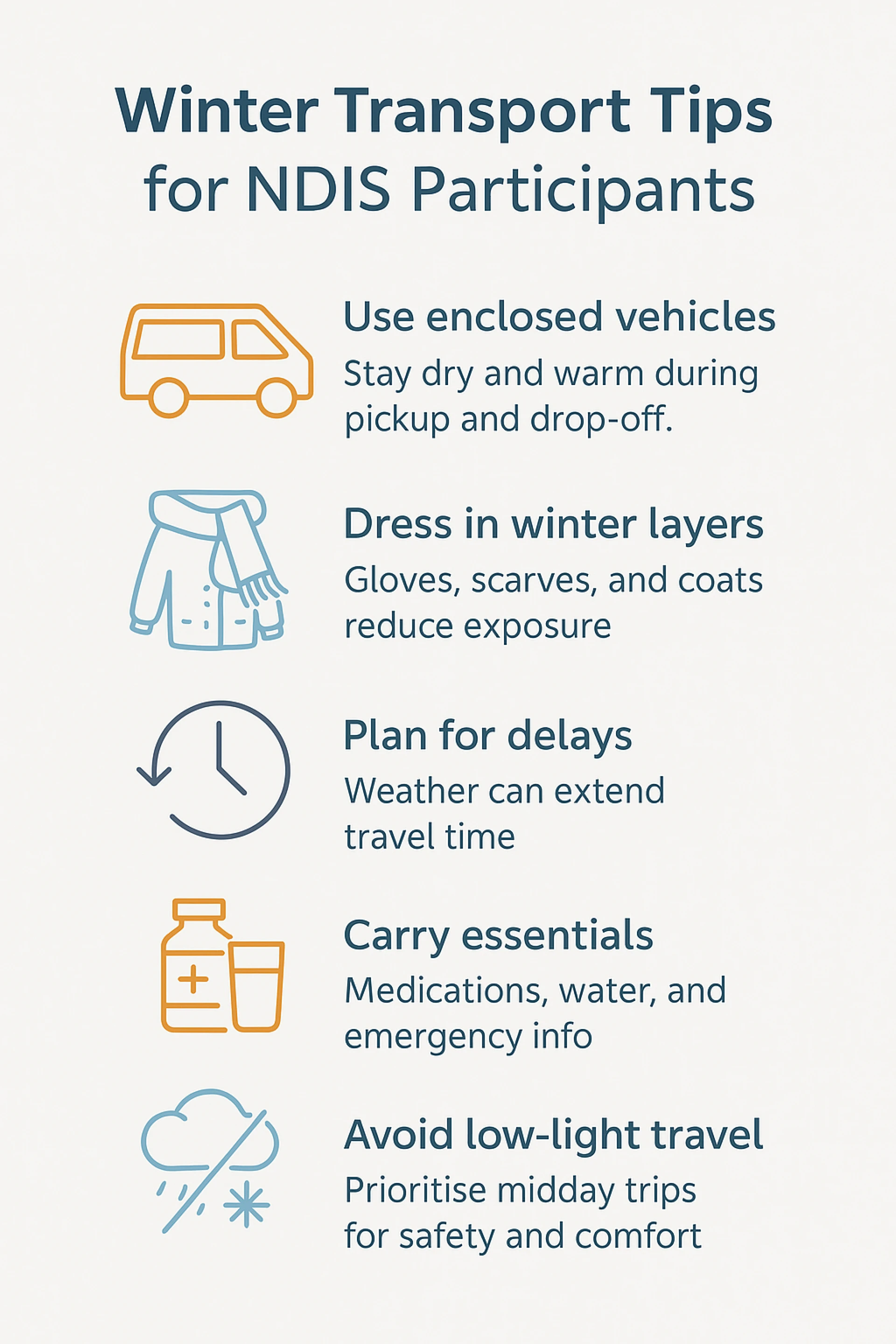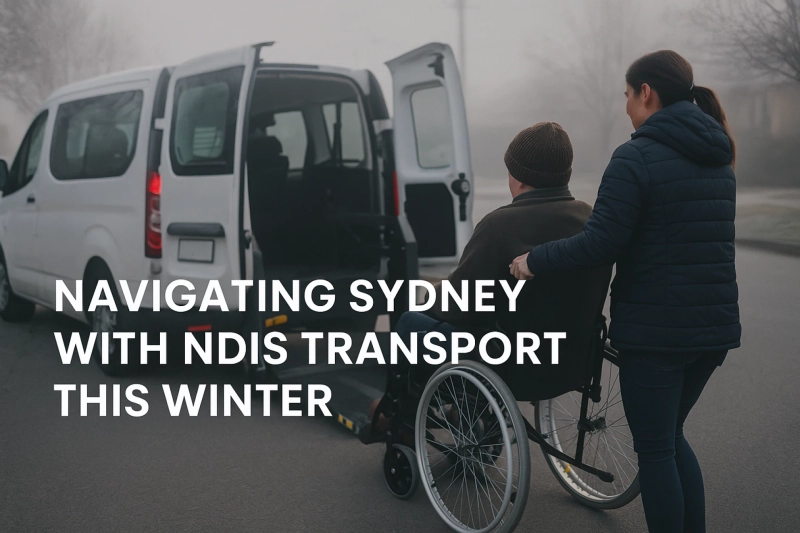Winter in Sydney brings more than crisp mornings and cooler days — it presents real challenges for people with disability who rely on consistent, accessible transport. Wet weather, shorter daylight hours, and cold-sensitive health conditions can all make routine travel more difficult. That’s why dependable NDIS transport assistance is especially important during the colder months.
For participants, carers, and support coordinators, now is the time to review how transport services can be tailored to meet seasonal needs. Here's how to get around Sydney safely and comfortably with NDIS-funded support this winter.
Why winter transport planning matters
It’s easy to underestimate how much the colder months affect mobility. From weather-related delays to the increased risk of illness, transport needs often shift between seasons, especially for those managing physical, cognitive, or sensory conditions.
- Cold temperatures can worsen arthritis, asthma, and fatigue
- Rain and fog can reduce visibility and make surfaces slippery
- Public transport may be harder to access or navigate
- Morning pickups happen in darker, colder conditions
- Carers and support workers may need extra time to assist
Planning ahead helps avoid last-minute stress and makes daily routines more manageable through the winter period.
What transport supports are available through the NDIS?
Participants may be eligible for various levels of transport support, depending on their plan goals, level of independence, and funding structure. These supports are designed to cover the gap for people who can’t use public transport safely or reliably.
- Direct funding under Core Supports for private transport
- Support worker assistance during travel (including wait time)
- Travel to medical appointments, community events, or therapy sessions
- Modified vehicle access for mobility aids
- Reimbursement for certain out-of-pocket travel expenses
More information on NDIS participant travel support is available through the official NDIS plan guidelines.
Tips for safer winter travel
Winter conditions require more thoughtful planning to avoid delays, discomfort, or risk during transport. Even small adjustments can significantly improve the travel experience.
- Choose vehicles with enclosed, heated cabins
- Allow extra travel time to account for weather-related slowdowns
- Pack warm layers, medications, and comfort items in a day bag
- Use slip-resistant shoes and walking aids when needed
- Schedule trips during daylight hours when possible
These types of accessible transport tips can help support coordinators and families fine-tune their daily travel plans.
Working with the right NDIS transport provider
Not all providers offer the same level of service, especially when it comes to winter readiness. Selecting the right partner can make a huge difference in daily outcomes and safety.
- Look for services with flexible scheduling in case of weather issues
- Confirm whether support workers are trained in mobility assistance
- Ask about hygiene, sanitisation, and vehicle maintenance policies
- Ensure the provider operates within your local Sydney area
- Review client testimonials or case manager feedback for reliability
A transport provider that communicates clearly, adapts to seasonal needs, and prioritises participant comfort will add long-term value to your plan.
Balancing independence and support
Transport isn't just about getting from A to B — it's also about maintaining independence and confidence. Especially during winter, when social isolation can increase, having reliable access to community activities is essential.
- Use scheduled transport to maintain regular therapy and exercise
- Consider short community outings to boost social engagement
- Coordinate pickup times to reduce waiting in cold weather
- Build small routines around travel to reinforce confidence
- Empower participants to choose their own winter-safe destinations
The right blend of support and autonomy leads to stronger outcomes and greater personal satisfaction.
Managing changes to regular routines
Winter often comes with unexpected disruptions — from health flare-ups to carer unavailability. Building flexible transport plans allows you to pivot without losing momentum in your day-to-day schedule.
- Keep a list of backup providers or support workers
- Reschedule non-urgent appointments during extreme weather
- Discuss alternate travel options with your coordinator
- Use ride-share or modified taxis when primary transport is unavailable
- Prioritise critical trips like medical and essential therapy
Having a contingency plan ensures that important appointments aren't missed and that participants feel secure even when plans shift.
Reducing health risks during winter travel
Winter is also a high-risk season for respiratory illnesses and temperature-sensitive conditions. Ensuring that transport routines account for health and comfort can prevent complications down the line.
- Use disinfected vehicles with proper ventilation
- Limit exposure by choosing door-to-door transport when possible
- Encourage masks, especially in enclosed shared vehicles
- Keep hand warmers or blankets in transit bags
- Avoid over-scheduling during peak cold weeks
Transport that protects a participant’s physical and emotional well-being is just as important as the destination itself.
Carer and support coordinator considerations
For carers and case managers, winter adds another layer of complexity to already demanding roles. Coordination requires more precision — and ideally, less friction.
- Book regular trips in advance to secure preferred time slots
- Communicate any health updates with transport providers early
- Provide clear instructions and access needs for drivers
- Review reports or logs to ensure punctuality and consistency
- Factor in weather forecasts for weekly scheduling
This approach reduces friction and ensures everyone involved stays on the same page.
Supporting mobility in colder months
Winter mobility isn’t just about vehicles — it’s about how we move, assist, and adapt. Transport that considers seasonal changes helps keep participants engaged and empowered.
Strategies that focus on mobility support in colder weather include adjusting walking routines, maintaining mobility aids, and increasing indoor activities when outdoor travel is limited. These layers of support help maintain overall well-being and confidence.

Final thoughts: Winter doesn’t have to slow you down
NDIS transport is more than a logistical service — it’s a foundation for daily life. When the cold settles in and the roads get wetter, having reliable, participant-centred transport means one less thing to worry about.
By choosing experienced NDIS transport providers, understanding your funding, and planning for flexibility, you can stay connected, supported, and safe — even on Sydney’s coldest days.



